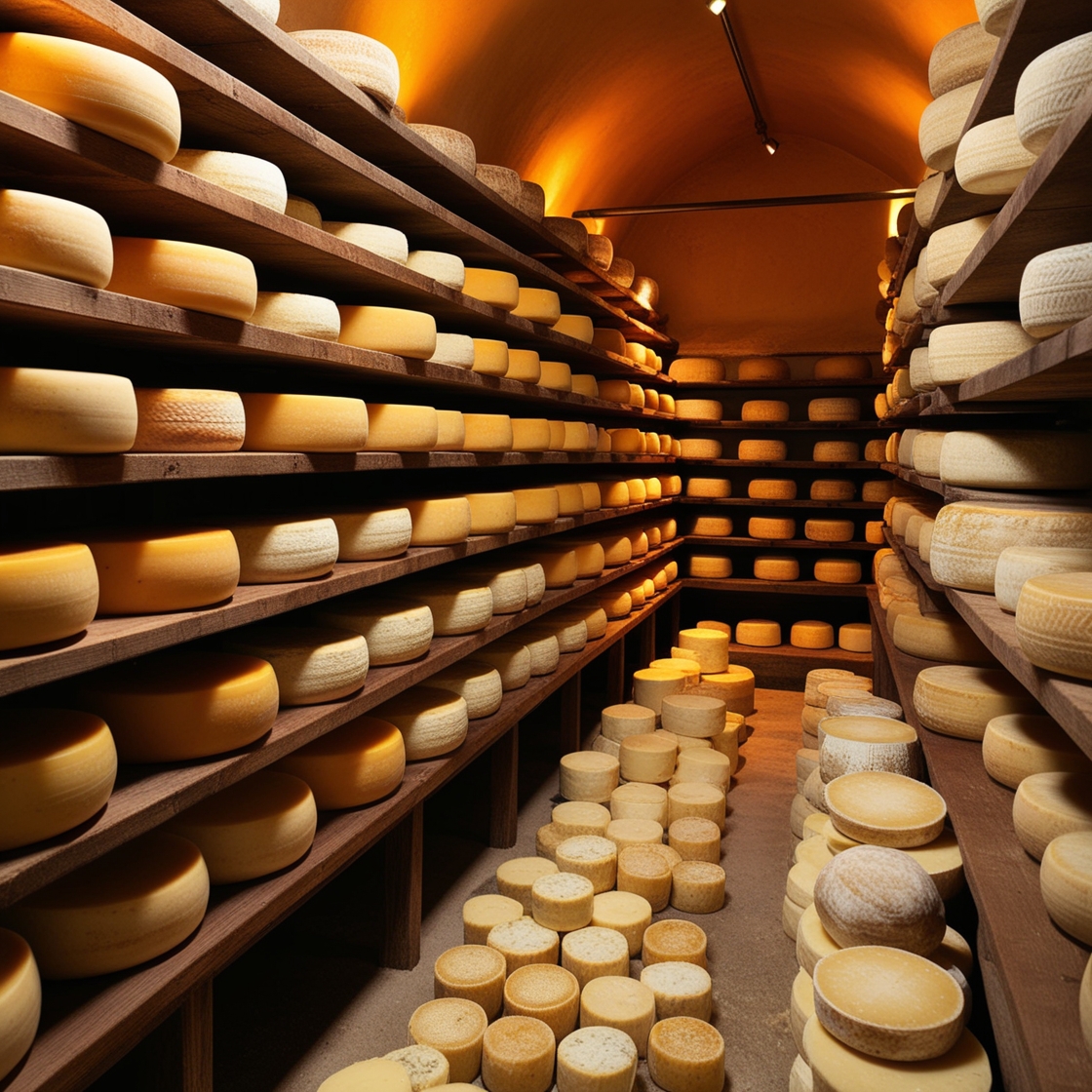
The Art of Cheese Aging: Science, Techniques, and Traditions
Key Takeaways
- Cheese aging (affinage) involves biochemical processes that develop flavors, textures, and aromas over time
- The main processes in cheese ripening are glycolysis, proteolysis, and lipolysis
- Temperature (10-15°C) and humidity (75-95%) control are critical for proper aging
- Different cheese types require specific aging periods: fresh (0-1 week), soft-ripened (3-6 weeks), semi-hard (1-6 months), hard (12+ months)
- Rinds play a crucial role in flavor development and can be bloomy, washed, or natural
- Home aging is possible with modified refrigerators and proper humidity control
- Famous aged cheeses include Parmigiano-Reggiano, aged cheddars, Gouda, and blue cheeses
Introduction to Cheese Aging
The transformation of fresh, mild cheese into complex, flavorful aged varieties is one of the most fascinating aspects of food science. Cheese aging, also known as affinage, isn't just a waiting game – it's a carefully orchestrated series of changes that develop distinctive flavors, textures, and aromas that can't be rushed.
This process can range from just a few days to several years, depending on the cheese type. What makes it so interesting is how it combines old-school knowledge passed down for centuries with modern scientific understanding. Aging cheese is truly where tradition meets science.
The craft of cheese aging has been refined over thousands of years. Early cheesemakers noticed how their products changed when stored in caves or cellars, and they figured out how to control these changes. Today's cheese guide experts still use many of these traditional techniques, but with the advantage of knowing exactly what's happening at a molecular level.
When you taste an aged cheese, you're experiencing the results of countless tiny transformations that have occurred inside that wheel or block. The sharp bite of an aged cheddar, the crunchy crystals in Parmigiano-Reggiano, or the creamy center of a perfectly ripened Camembert – these qualities don't exist in fresh cheese but develop gradually through aging.

A traditional cheese aging room with wooden shelves lined with wheels of cheese at various stages of maturation, highlighting the craft of affinage
The Science Behind Cheese Ripening
Cheese aging isn't just about waiting around – it's a complex dance of chemical reactions that transform simple milk into something amazing. During ripening, three main processes work together: glycolysis breaks down sugars, proteolysis breaks down proteins, and lipolysis breaks down fats. These reactions create the flavors, aromas, and textures that make aged cheese so special.
As cheese ages, it slowly loses moisture while friendly bacteria continue to work inside. These helpful microbes convert lactose (milk sugar) into lactic acid and build amino acids that give aged cheese its distinctive taste. You can actually see evidence of this process in well-aged Parmigiano Reggiano – those crunchy white specks aren't salt but amino acid crystals called tyrosine!
Temperature plays a huge role in controlling these reactions. Most cheeses are aged in cool environments between 10-15°C (50-59°F), though the exact temperature depends on the cheese type. Too warm, and the cheese might develop too quickly or grow harmful bacteria. Too cold, and the aging process practically stops.
Different cheeses get their unique characteristics from specific microorganisms. The blue veins in Roquefort come from Penicillium roqueforti mold, while the strong smell of washed-rind cheeses comes from surface bacteria. These microbe communities evolve throughout the aging process, with different species taking over at various stages.
Here's a breakdown of the key biochemical processes:
| Process | What It Does | Example Result |
|---|---|---|
| Glycolysis | Breaks down lactose (milk sugar) | Develops acidity and base flavors |
| Proteolysis | Breaks down proteins | Creates umami flavors and changes texture |
| Lipolysis | Breaks down fats | Produces flavor compounds and aromas |
Environmental Factors in Cheese Aging
The environment where cheese ages has a massive impact on how it turns out. Beyond temperature, humidity is probably the most important factor. Most cheeses need high humidity levels between 75-95% to age properly. When it's too dry, the cheese can crack or dry out too fast. The right amount of humidity lets the rind develop correctly while preventing excessive moisture loss.
Air circulation is another big deal in cheese aging. Good ventilation ensures the right oxygen-carbon dioxide balance, which affects the microbes responsible for flavor development. Without enough airflow, unwanted bacteria might take over and spoil the cheese. But too much air movement can dry out the surface too quickly and mess up the aging.
The physical space matters too. Traditional aging environments like caves offer naturally stable conditions that cheesemakers have used for centuries. These places develop their own unique microbial ecosystems over time, which can give subtle characteristics to cheeses aged there. This explains why certain traditional cheeses must still be aged in specific locations to maintain their authentic character.
When you discover traditionally-made cheeses, you're often tasting the influence of their aging environment. The arrangement of cheeses within that space also affects ripening. Multiple cheeses stored together create higher humidity than a single cheese would generate alone. Professional cheese agers constantly monitor and adjust conditions based on this dynamic relationship.
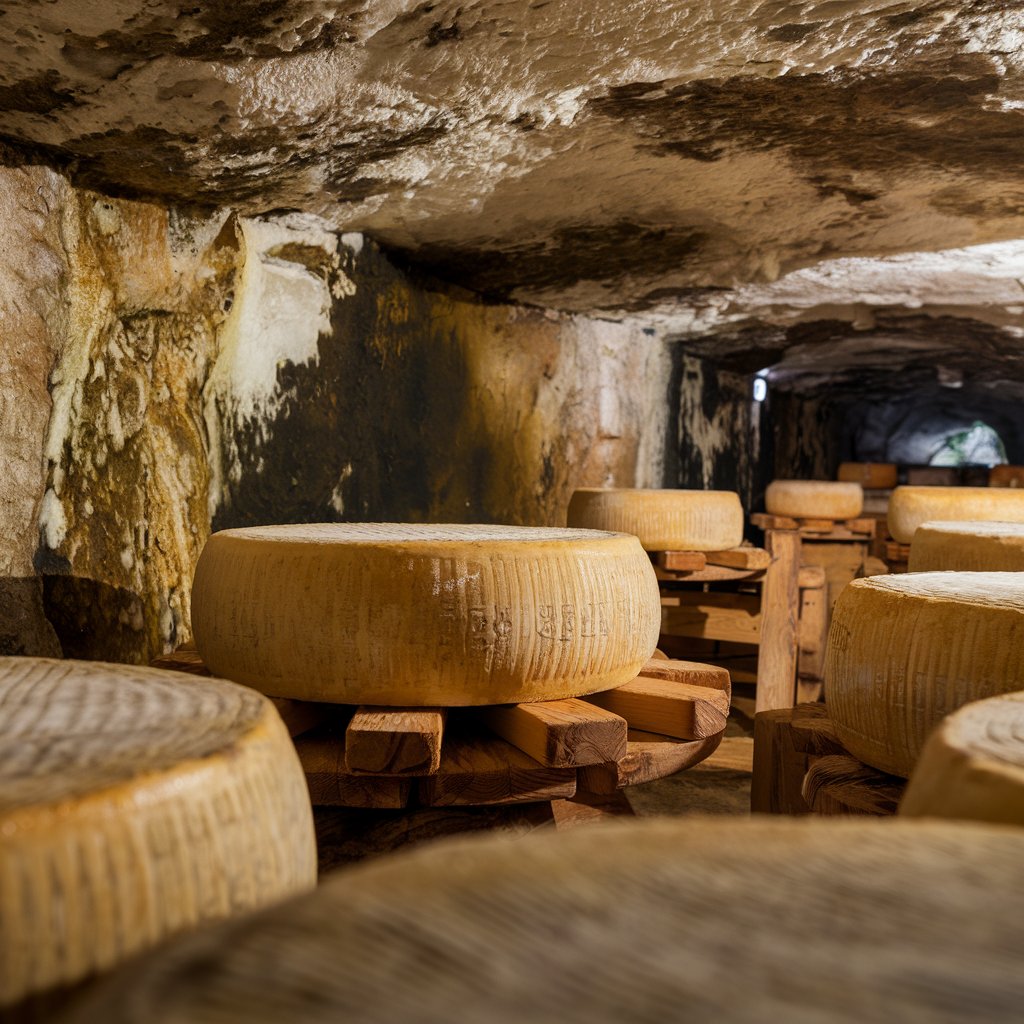
Natural cave aging system showing cheese wheels resting on wooden boards with ambient mold development visible on the cave walls
Modern Aging Technologies and Innovations
The cheese world hasn't been immune to technological progress. Modern aging cabinets represent one of the biggest advancements, offering unprecedented control over temperature, humidity, and air circulation. These specialized units let producers create perfect environments for different cheese varieties, regardless of the weather outside or seasonal changes.
With electronic regulation systems, producers can maintain exact specifications throughout the aging period. Some advanced cabinets even feature programmable ripening cycles that automatically adjust conditions at different stages. This precision allows cheesemakers to guide the biochemical processes with greater control than ever before, ensuring consistent quality across batches.
Scientific research continues to push the boundaries of cheese aging. Researchers from the DTU National Food Institute have developed new cheese cultures that can cut traditional ripening times in half while maintaining or even improving flavor development. These breakthroughs offer significant sustainability benefits by reducing energy use during aging.
Despite these innovations, many producers still incorporate traditional aging methods. They recognize that historical approaches can impart unique qualities to their cheese. Some prestigious varieties, like certain hard cheese types, maintain strict requirements for aging in designated natural caves, preserving connections to centuries-old production methods.
The most successful producers often blend innovation with tradition, using modern monitoring technology alongside time-honored techniques. This balance allows them to create consistent, high-quality cheeses while honoring the craft's heritage.
Aging Techniques and Rind Development
The development of a cheese's rind is one of the most visible aspects of aging and significantly influences both flavor and texture. Different aging techniques produce distinct rind types, each contributing unique characteristics to the finished cheese. The rind isn't just a protective layer – it's a semi-permeable boundary that regulates moisture exchange while providing habitat for beneficial microorganisms.
Bloomy rinds, characteristic of Brie and Camembert, develop from specific molds (typically Penicillium candidum) that form a downy white layer on the cheese surface. These molds grow outward while releasing enzymes that gradually soften the cheese from the exterior inward, creating that characteristic creamy texture. The bloomy rind contributes earthy, mushroom-like flavors that complement the buttery interior.
Washed-rind cheeses follow a different path. Their surface is regularly scrubbed with brine, alcohol, or other solutions during ripening. This washing suppresses mold growth while encouraging the development of bacteria like Brevibacterium linens, which gives these cheeses their characteristically pungent aromas and distinctive orange-red rinds. Examples include Limburger, Époisses, and Taleggio, all known for their robust flavors.
Natural rinds develop when cheese is aged without specific surface treatments, allowing indigenous microflora to colonize the exterior naturally. These rinds typically appear on traditional hard cheeses like Parmigiano-Reggiano and certain farmhouse cheddars. Over months or years of aging, these rinds develop complex ecosystems that contribute subtle flavor compounds while protecting the cheese from undesirable organisms.
The techniques for developing and maintaining these different rind types represent specialized knowledge passed down through generations. The timing of turning cheeses, controlling humidity levels, and monitoring rind development all require experience and careful attention.
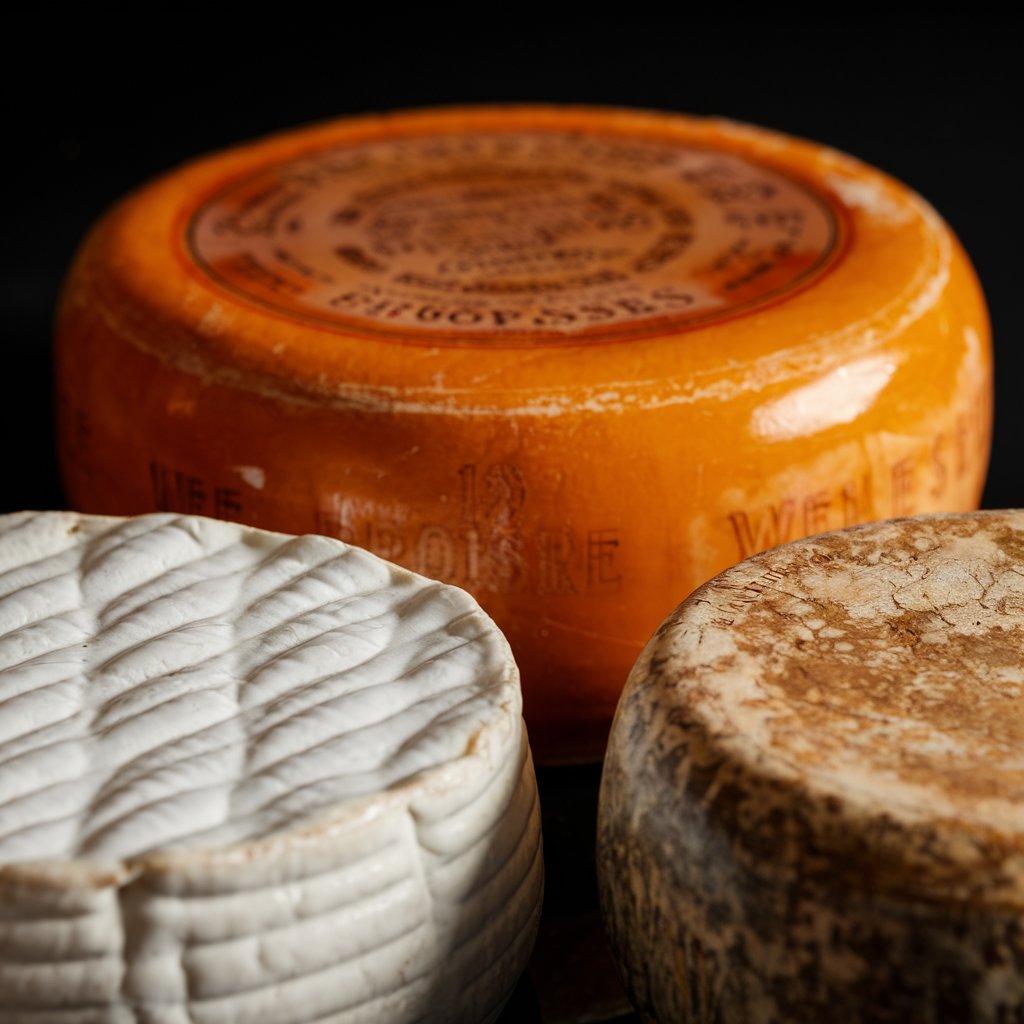
Close-up comparison of three cheese rind types: bloomy white rind (Brie), orange washed rind (Epoisses), and natural rind (aged Cheddar) showing distinctive textures and colors
Aging Periods for Different Cheese Varieties
The duration of aging dramatically influences a cheese's final characteristics. Different varieties require specific time periods to develop their optimal flavor profiles. Here's how various cheese types transform during aging:
Fresh cheeses like mozzarella or ricotta undergo minimal aging, typically just 0-1 week. These cheeses emphasize fresh milk characteristics rather than complex flavors. Their brief maturation period highlights that not all cheeses benefit from prolonged aging.
Soft-ripened cheeses like Brie and Camembert require about 3-6 weeks to develop their characteristic bloomy rinds and creamy interiors. During this relatively short ripening period, enzymes from surface molds gradually break down proteins in the interior. This process, called proteolysis, progresses from the rind inward, creating a textural contrast between the firmer center and increasingly creamy edges.
Semi-hard cheeses show greater aging flexibility. Young Gouda ages for 1-3 months, while medium cheddars typically mature for 3-6 months. These moderate aging periods allow for significant flavor development while maintaining relatively smooth textures. A young cheddar offers milky, lactic notes and a smooth texture, while the same cheese aged longer develops increasingly complex, sharp flavors and a firmer consistency.
Hard cheeses represent the most extended aging category. Parmigiano-Reggiano commonly ages 12-36 months or even longer. These extended maturation periods allow for extensive moisture loss and protein breakdown, concentrating flavors and developing the characteristic crystalline structure. The significant investment of time translates directly to concentrated flavor intensity, with sweet, nutty, and savory notes emerging.
Blue cheeses follow their own unique aging patterns, typically requiring 2-6 months to develop their characteristic veining and robust flavors. The controlled introduction of Penicillium roqueforti or related molds, combined with specific piercing techniques that allow oxygen to penetrate the cheese interior, creates the distinctive marbled appearance and complex flavors.
You can explore more about how aging affects texture in our comprehensive guide.
| Cheese Type | Aging Period | Characteristics Developed |
|---|---|---|
| Fresh (Ricotta, Mozzarella) | 0-1 week | Mild, milky flavors, high moisture |
| Soft-ripened (Brie, Camembert) | 3-6 weeks | Bloomy rind, creamy texture |
| Semi-hard (Young Gouda, Cheddar) | 1-6 months | Developing complexity, firm texture |
| Hard (Parmigiano-Reggiano) | 12-36+ months | Concentrated flavors, crystalline structure |
| Blue (Roquefort, Stilton) | 2-6 months | Blue veining, pungent flavors |
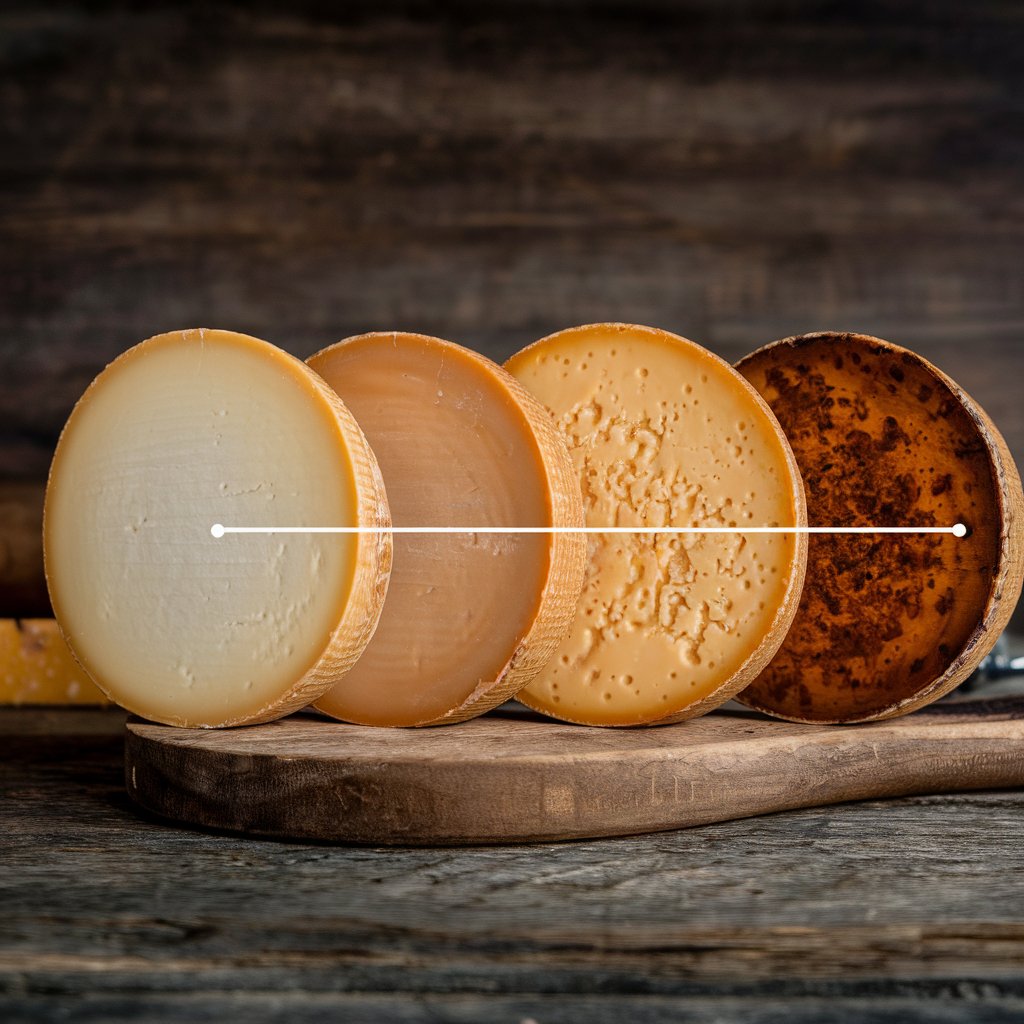
Visual timeline showing the transformation of a wheel of cheese through the aging process from fresh (white, uniform texture) to fully aged (amber color with visible crystallization)
Home Aging Techniques and Equipment
The growing interest in artisanal foods has inspired many cheese lovers to try aging cheese at home. While commercial producers use specialized equipment, home aging can be done with modified household items and careful attention to environmental conditions. The key challenge is maintaining consistent temperature and humidity levels.
A standard refrigerator is the most accessible starting point, though it has limitations. Regular fridges typically maintain temperatures around 38-40°F (3-4°C), which is about 10-15 degrees cooler than ideal cheese aging conditions. This lower temperature slows the aging process considerably. Standard refrigerators also tend to reduce humidity, potentially causing cheese to dry out too quickly.
To work around these challenges, place cheese in airtight containers that help maintain humidity from the cheese itself. A good rule of thumb is 40% cheese and 60% empty space within the container. This creates a mini-environment that's more suitable for aging.
For more serious cheese enthusiasts, converting a spare refrigerator offers better results. By adding an external temperature controller, a standard or dorm-sized refrigerator can be regulated to maintain the ideal 52-55°F (11-13°C) environment. These controllers simply plug into a standard outlet, with the refrigerator then plugging into the controller unit. Humidity within these converted units can be managed by placing a shallow pan of water with a sterilized sponge inside.
Monitoring instruments are essential for success. A digital hygrometer measures humidity levels, with many models offering alert functions that notify you when conditions fall outside ideal parameters. Temperature monitoring ensures the aging environment remains stable. Regular checking allows for adjustments as needed, such as misting interior walls with sterile water when humidity drops.
For more information about home cheese aging, visit our about page where we share tips from professional affineurs (cheese agers).
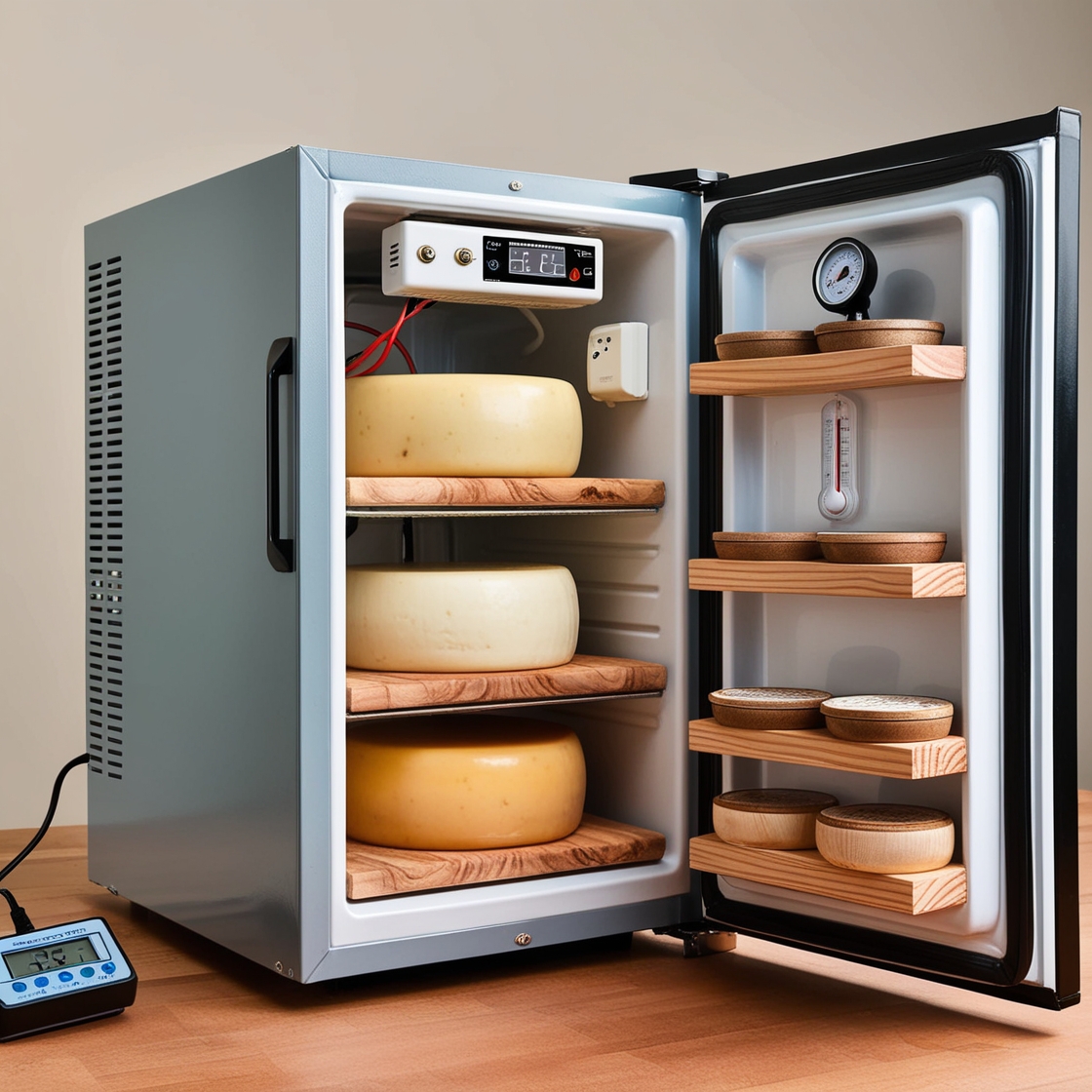
DIY home cheese aging setup showing a converted refrigerator with temperature controller, humidity gauge, and proper cheese storage containers on wooden shelves
Notable Aged Cheeses and Their Characteristics
The world of aged cheeses offers remarkable diversity, with distinctive varieties reflecting regional traditions, milk types, and aging techniques. Here are some of the most celebrated aged cheeses and what makes them special:
Parmigiano Reggiano stands as perhaps the most internationally recognized aged cheese. Typically matured for 12-36 months, it develops a granular texture and complex flavor profile. During extended aging, the cheese forms tyrosine crystals that provide its signature crunch, while flavors evolve from sweet and mild to increasingly complex with notes of fruit, nuts, and umami. The strictly controlled production methods maintain this cheese's consistent quality.
Aged cheddars demonstrate remarkable transformation through extended maturation. Varieties range from relatively mild 3-6 month versions to intensely sharp examples aged 2+ years. The traditional aging process involves wrapping the cheese in cloth and coating it with lard or butter to allow slow moisture loss while preventing mold growth. As cheddar ages, it develops increasingly complex flavors, progressing from milky and lactic to sharp and savory, sometimes with sweet caramel notes in well-aged examples.
Gouda cheese offers fascinating insight into how aging transforms flavor. Young versions feature mild, sweet character while aged Gouda (particularly those aged 2+ years) develops pronounced caramel sweetness alongside complex savory notes. The traditional aging process involves coating the cheese in wax or plastic, which limits moisture loss and oxygen exposure. The resulting aged Gouda maintains a relatively smooth texture while developing concentrated flavor compounds that include notes of butterscotch and nuts.
Blue cheeses represent a distinctive category, with famous examples including Stilton and Gorgonzola. These cheeses develop their characteristic blue-green veining through controlled introduction of Penicillium molds and strategic piercing that allows oxygen to reach the cheese interior. The aging environments maintain particularly high humidity levels to support mold growth. The aging process produces distinctive pepperiness and complex flavors ranging from mild creaminess to intense spicy sharpness.
Alpine-style cheeses like Gruyère and Comté undergo extensive aging that contributes to their distinctive flavors and remarkable melting properties. These large wheel cheeses typically mature for 6-24 months in cool, humid environments, developing sweet, nutty characteristics with hints of fruit and herbs reflective of the mountain pastures where their milk originates.
Explore more about cheese varieties by origin in our comprehensive guide.
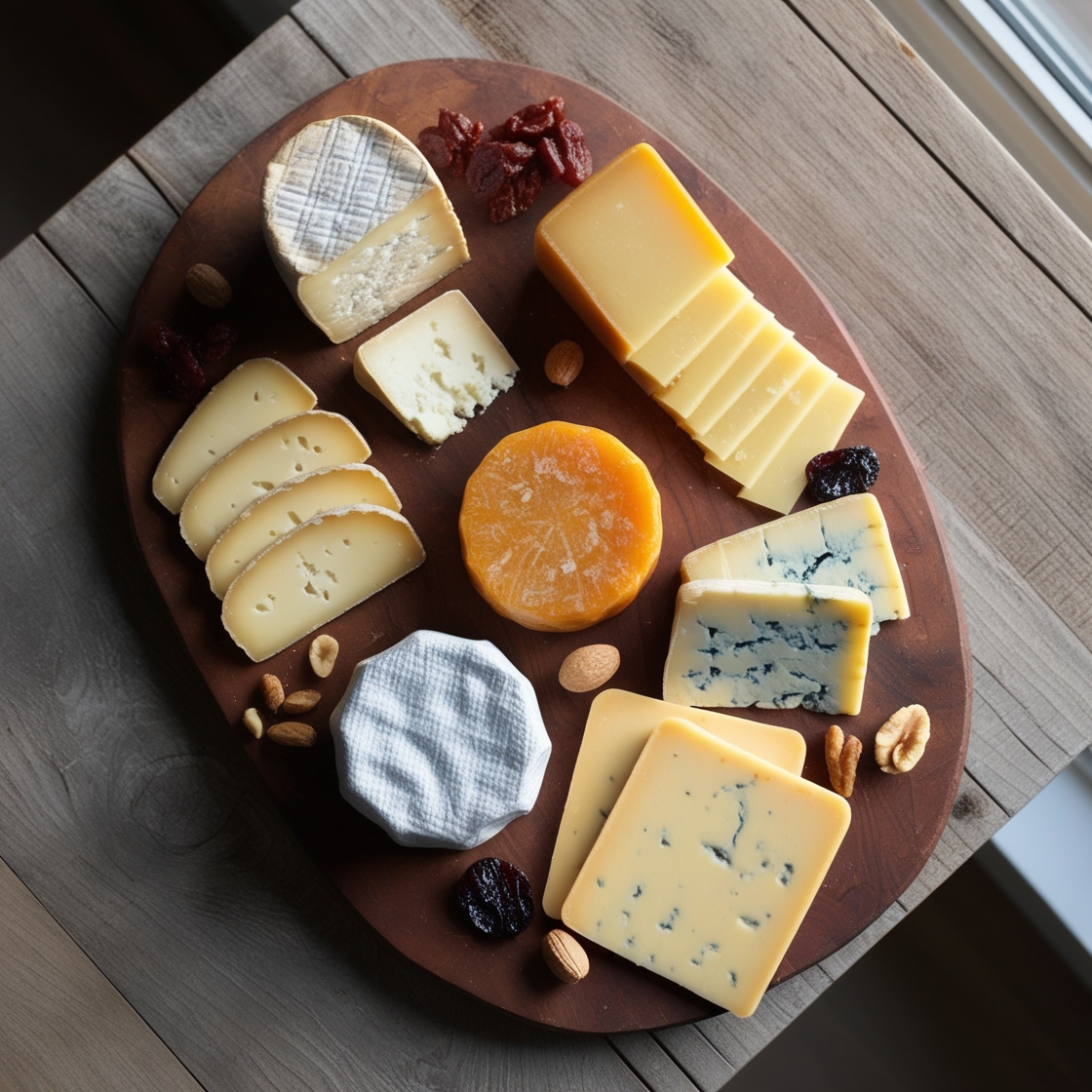
Gourmet cheese board featuring various aged cheeses cut to show internal texture - Parmigiano-Reggiano with visible crystallization, aged Gouda with caramel color, Stilton with blue veining, and clothbound cheddar
Innovations and Future Directions in Cheese Aging
The cheese industry continues to evolve, blending traditional knowledge with scientific advances. Recent research from the DTU National Food Institute has developed innovative cheese cultures capable of reducing traditional ripening times by half while maintaining or even improving flavor development. This breakthrough offers significant sustainability benefits by reducing energy consumption during aging while potentially increasing production capacity.
Professional aging cabinets represent another significant advancement, offering unprecedented environmental control compared to traditional methods. These specialized units enable producers to create precisely tailored conditions for different cheese varieties, regardless of external climate variations. With electronic regulation systems, producers maintain exact specifications throughout the aging period, ensuring consistent quality across production batches.
The growing consumer interest in artisanal and specialty cheeses has spurred innovation in small-scale aging technology. Equipment manufacturers now offer scaled-down professional aging units designed for small producers, restaurants, and specialty shops. This democratization of aging technology has contributed to the expansion of local cheese production and aging programs, connecting consumers more directly with the aging process.
Despite these technological advancements, many producers continue incorporating traditional aging methods, recognizing the unique qualities that historical approaches impart. Some prestigious cheese varieties maintain strict requirements for aging in designated natural environments, preserving connections to centuries-old production methods. The natural microbial ecosystems that develop in traditional aging spaces contribute subtle characteristics impossible to replicate precisely through technological means alone.
The future of cheese aging likely involves continued refinement of both technological and traditional approaches. Ongoing research into the specific microorganisms and enzymes responsible for desirable flavor development may lead to more precisely tailored cultures that enhance particular characteristics while reducing aging time. Advanced monitoring systems using sensor technology could provide more detailed information about biochemical processes occurring within aging cheese, allowing for more responsive adjustments to environmental conditions.

Side-by-side comparison of traditional and modern cheese aging - modern stainless steel aging cabinets with digital controls next to traditional wooden shelving in a stone cave
Frequently Asked Questions About Cheese Aging
How can I tell if a cheese is properly aged?
Look for signs specific to the cheese type. Hard cheeses should have uniform color throughout with possibly some crystallization. Bloomy-rind cheeses should feel slightly soft but not runny. The rind should be fully developed without bare patches. Trust your senses – properly aged cheese should have balanced flavors without ammonia-like or soapy tastes.
Can I age cheese that I buy from the grocery store?
Some commercial cheeses can be aged further at home, particularly firmer varieties like cheddar or gouda. However, pre-packaged cheeses often contain preservatives or have been stabilized to prevent further aging. For best results, purchase cheeses specifically labeled "suitable for further aging" or buy directly from cheese shops that can recommend good candidates.
Why do some aged cheeses have crystals in them?
Those crunchy crystals that form in well-aged cheeses aren't salt – they're amino acid clusters, most commonly tyrosine or calcium lactate. They're a natural result of protein breakdown during extended aging and are generally considered a mark of a well-aged cheese. You'll commonly find them in aged Parmigiano-Reggiano, aged Gouda, and some aged cheddars.
Is mold on cheese always safe?
Not all molds are desirable or safe. Molds specifically introduced during cheesemaking (like the white Penicillium candidum on Brie or blue-green Penicillium roqueforti in blue cheese) are safe and essential to flavor development. However, black, pink, or bright-colored molds that weren't intentionally part of the cheese are generally considered spoilage and should be avoided.
What's the difference between cave-aged and cellar-aged cheese?
Natural caves provide very stable temperature and humidity conditions year-round, typically around 50-55°F with 85-95% humidity. They also contain native microflora that can influence flavor development. Cellar aging typically refers to aging in built environments that attempt to replicate cave conditions but may have more temperature and humidity fluctuations or different microbial profiles, resulting in subtly different flavor development.
How does aging affect the nutrition of cheese?
Aging generally concentrates nutrients as moisture evaporates from the cheese. Protein content typically increases per unit weight, and the proteins become more digestible due to breakdown during aging. Some studies suggest that aged cheeses may contain higher levels of vitamin K2 and other beneficial compounds produced through bacterial activity. However, sodium content also increases as moisture decreases, making aged cheeses generally higher in salt by weight.